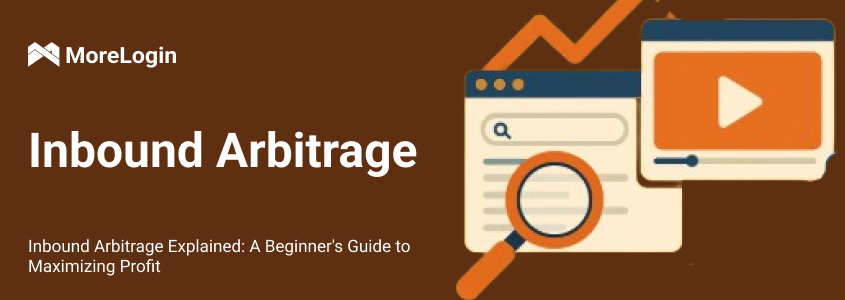
- Product

- Pricing
- Affiliate Program
- Use Cases
- Resource


Inbound arbitrage is rapidly emerging as a profitable digital strategy for marketers and online entrepreneurs. By leveraging inbound traffic and redirecting it to monetizable offers, this method eliminates the need for heavy branding, complex logistics, or even original products.
This article explores how inbound arbitrage works, its core benefits, and step-by-step instructions to implement it effectively. This guide provides a clear and practical overview of everything you need to get started.
Inbound arbitrage is a strategy where businesses take existing incoming traffic and redirect it to offers that are more likely to convert and make money. Instead of trying to create new interest from scratch, this method focuses on using the demand that already exists.
Unlike traditional arbitrage, which is about making money from price differences, inbound arbitrage is about making money from how traffic flows.
The idea is to find traffic sources that are undervalued or not fully used—like search engine visits, social media clicks, or paid ads—and turn them into profit.
For example, if a TikTok account gets a lot of views, instead of just building brand awareness, someone using inbound arbitrage might send that traffic to affiliate products, dropshipping stores, or digital downloads to earn revenue.
It’s important to understand the benefits of inbound arbitrage before using it. Here are the main advantages that make it a popular choice for digital entrepreneurs.
Inbound arbitrage allows entrepreneurs to bypass many traditional costs associated with product development, customer service, and inventory. By leveraging affiliate networks and pre-built offers, operators can maintain a lean business structure.
Since inbound arbitrage uses real-time data from inbound traffic flows, operators can adapt to changing market trends faster. If a certain offer stops converting, traffic can be redirected within minutes to a new one with better ROI.
Operators are not limited to one product or offer. A single traffic source can be monetized in multiple ways: affiliate links, display ads, digital product sales, or lead generation. This diversification protects against revenue volatility.

Steps To Carry Out Inbound Arbitrage
Once you understand the benefits, the next step is learning how to execute inbound arbitrage effectively. The following steps break down the process into clear, actionable phases.
Start by analyzing which platforms or channels bring consistent traffic. Examples include TikTok, Reddit, Quora, SEO blogs, and Telegram channels.
Understand what your visitors are looking for. Are they researching? Looking to buy? Seeking solutions? Tools like Google Analytics and Heatmaps can help.
Use affiliate platforms like ClickBank, Impact, or ShareASale to find suitable offers. Match these offers to the intent of your traffic.
You can either build a custom landing page to pre-frame your offer or directly redirect traffic using tracking links and shorteners.
Use analytics tools to measure performance. Metrics like CTR, conversion rate, and EPC (earnings per click) guide your decisions. A/B testing is essential.
After setting up the basic infrastructure, the next goal is to optimize your operations to achieve the highest possible return. Here are proven methods to increase profitability in inbound arbitrage.
Not all offers are created equal. Prioritize:
High commission rate
Strong landing page design
Short conversion funnels
Low refund rate
A mismatched product will lower profitability despite high traffic volumes.
To scale operations efficiently, use tools that automate repetitive tasks. One example is telegram bots for arbitrage, offered by Morelogin. This tool can manage multiple accounts, control traffic routing, and reduce manual overhead, especially when operating at scale.
Use heatmaps, funnel visualization, and retargeting strategies to improve your ROI. Retarget visitors with personalized offers or guide them back to the funnel with email and push notifications.

Relying on a single traffic source limits long-term profitability. To maximize returns, operators should test and scale into emerging channels such as Pinterest, niche forums, LinkedIn, or Telegram groups. These channels often have less competition and can deliver high-converting, intent-driven traffic. Testing new platforms ensures your funnel stays fresh and your earnings diversified.
Even with the right strategy and tools, inbound arbitrage comes with its own set of difficulties. Understanding these common challenges—and how to solve them—can prevent costly mistakes and improve your long-term success.
Problem: Sending fitness traffic to a financial product.
Solution: Align the traffic source with a contextually relevant offer. Use surveys or quizzes to segment intent.
Problem: Arbitrage pages flagged by ad networks.
Solution: Use cloaking tools carefully, or stick to compliant platforms. Monitor ad guidelines.
Problem: The same traffic sees the same offer repeatedly.
Solution: Rotate offers and test new creatives. Introduce time-limited campaigns or seasonal variations.
Problem: Difficult to trace which channel yields the most profit.
Solution: Use UTM parameters and advanced analytics like postback tracking.
Problem: Poor reviews or low conversion rates.
Solution: Study inbound arbitrage reviews and complaints to understand what common user frustrations are, and avoid repeating them.
Inbound arbitrage is a powerful strategy to monetize traffic with minimal overhead and high scalability. By understanding traffic intent, aligning with high-converting offers, and automating processes, beginners can turn even small traffic streams into meaningful profit.
It’s not without challenges — platform rules, offer mismatches, and tracking issues require strategic thinking. However, with the right tools and continuous optimization, success is achievable.
Start today by analyzing your traffic sources, testing offers, and leveraging platforms like Morelogin to automate and scale.
TikTok, Reddit, SEO blogs, Quora, and Telegram groups are commonly used due to their large user bases and diverse content formats. The ideal platform depends on your niche and offer.
No advanced technical skills are required. Beginners can use off-the-shelf tools and platforms. However, familiarity with traffic analytics and basic tracking can significantly boost results.
Some users see initial results within days, especially when working with high-traffic sources. However, consistent optimization over 2–4 weeks is often necessary for reliable performance.